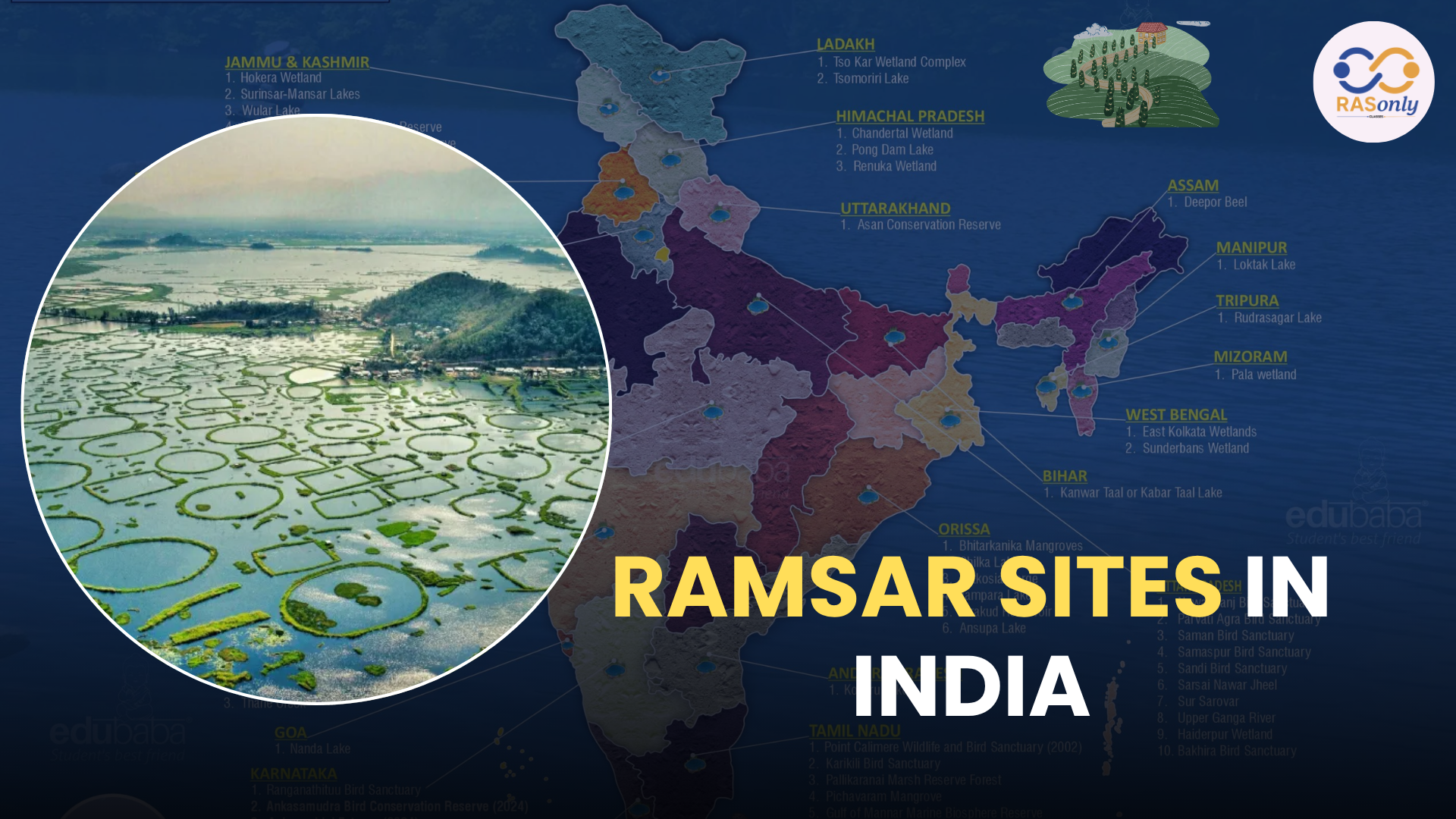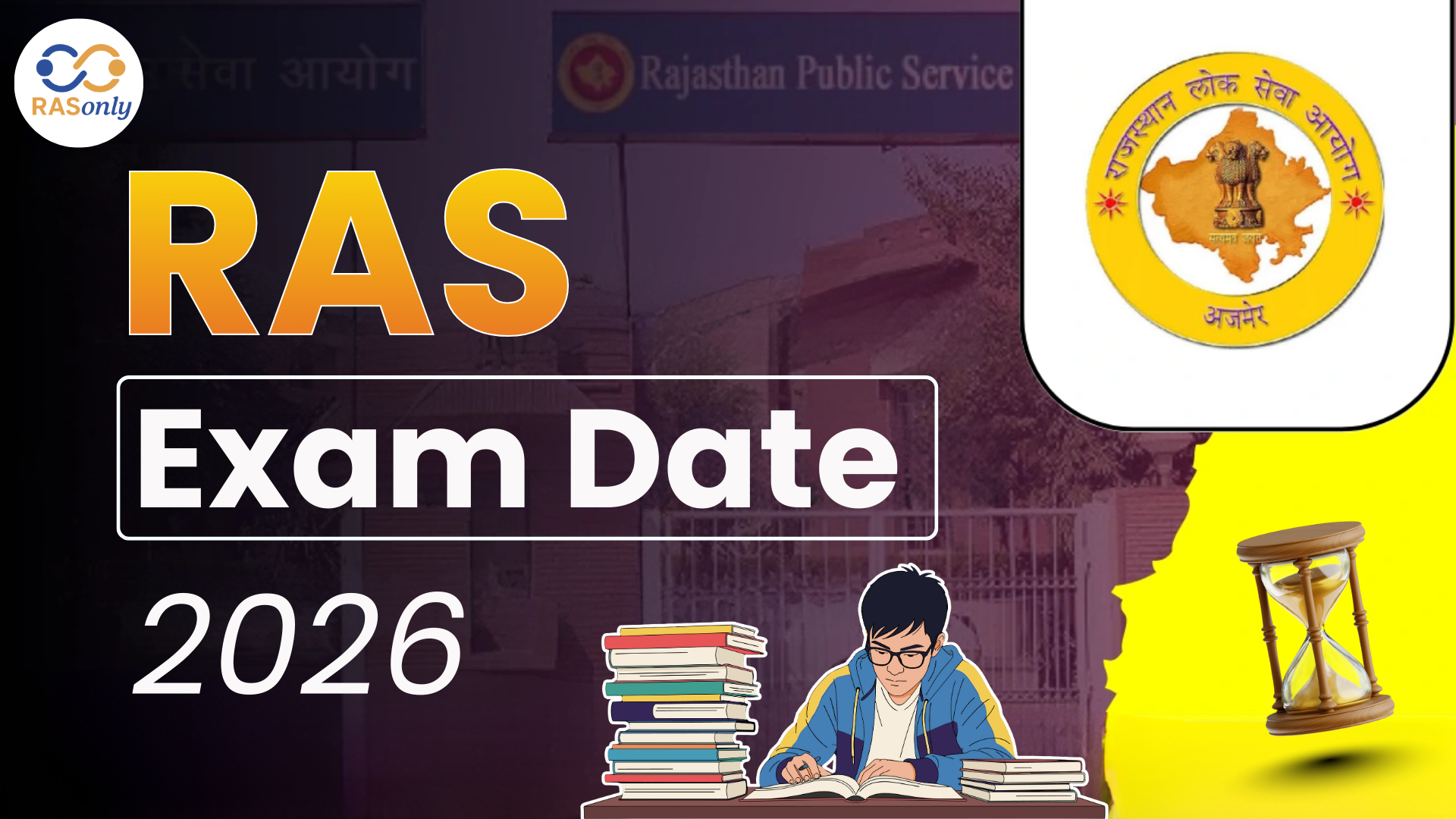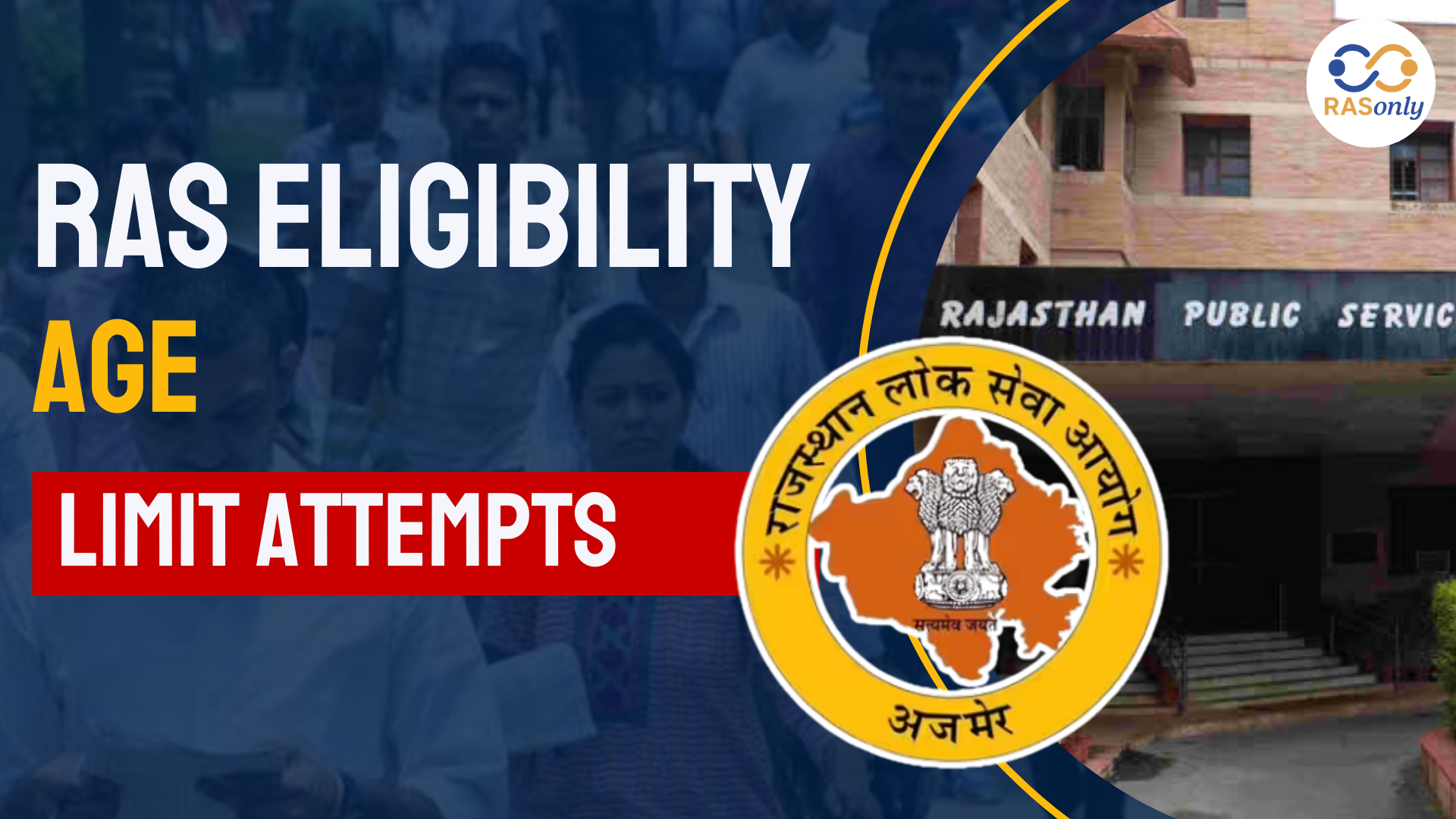RAS Exam Date 2026 for Notification, Prelims, Mains Date
- >
- RAS Preparation Resources
- >
- Ramsar Sites in India 2025: List, Importance & New Additions
Ramsar Sites in India 2025: List, Importance & New Additions


India contains a wide variety of wetlands of which most are Ramsar Sites or wetlands of international importance as stipulated by the Ramsar Convention 1971. Such sensitive and ecologically rich ecosystems are of critical importance in conservation of biodiversity, regulation of water and climate and livelihood support. India has been able to grow its list of the Ramsar sites tremendously as of 2025 making India the country with the largest number of Ramsar sites in Asia. The present academic review elaborates the history, importance, the count, current trends, and conservation activities related to the Ramsar Sites in India and especially in Rajasthan and other high priority states.
What is a Ramsar Site?
A Ramsar Site is a wetland of international importance, as referred to in the Ramsar Convention which is an intergovernmental treaty agreed upon in 1971 in Ramsar, Iran, towards the conservation and wise use of wetlands.
- Examples of wetlands are marshes, lakes, rivers, mangroves, peatlands, coral reefs and channels and man-made wetlands such as reservoirs and fish ponds.
- These sites are well known either because of their ecological, botanical, zoological, limnological or hydrological relevance.
- Ramsar Sites seek sustainability at the use of wetland ecosystems by sustaining biodiversity and human communities.
Key Details for RPSC RAS Mains
Background and History of Ramsar Sites
The Ramsar Sites initiative was created on the basis of the increasing national concern over declining wetlands due to the fact that this is one of the most productive ecosystems on earth. Such habitats were threatened by industrialisation, land conversion and pollution.
Historical Milestones:
- 1960s: European ornithologists and ecologists were sounding wart alarms about disappearing wetland habitat, as especially migratory waterbirds.
- 1971: In Iran, Ramsar Convention came into existence when the convention was signed on February 2, 1971 in Ramsar.
- 1982: India was the Contracting Party of the Convention on February 1, 1982.
- 1981: India assigned both of the first two Ramsar Sites namely, Chilika Lake (Odisha) and Keoladeo National Park (Rajasthan) in India.
- Post-2019: India saw an explosive growth of areas covered by Ramsar because it had active government policies.
The Convention has since developed over time so that it is not only applicable to the protection of birds, but also to its sustainability regarding the wise uses of wetlands that include conservation, research, education and livelihood issues.
Recent Developments (2025 Update)
In the year 2025, India has made some vital moves towards doing more to conserve its wetlands:
- In June 2025, there were a total of 91 Ramsar sites in India.
- June 2025 Additions:
- Khichan (Phalodi) -Rajasthan
- Menar (Udaipur) Rajasthan
- Previously Added (February 2, 2025):
- Sakkarakottai Bird Sanctuary, Tamil Nadu
- Therthangal Bird Sanctuary (Tamil Nadu)
- Sikkim Khecheopalri Wetland, Sikkim
- Jharkhand, Udhwa Lake
These extensions elevate India as the largest in Asia and the third broadly speaking the world in the number of Ramsar Sites, after the UK and Mexico.
Number of Ramsar Sites in India (As of June 2025)
|
Parameter |
Details |
|
Total Ramsar Sites |
91 |
|
Total Area Covered |
Approx. 13.26 lakh hectares |
|
State with Highest Sites |
Tamil Nadu (20 Sites) |
|
Global Rank |
1st in Asia, 3rd globally |
Number of Ramsar Sites in Rajasthan (2025)
In Rajasthan there are 4 Ramsar Sites:
- Keoladeo national park (Designated 1981)
- Sambhar Lake (Designated 1990)
- Khichan (Phalodi) June 2025
- Menar (Udaipur) - Established- June 2025
State-wise Area of Ramsar Sites in India
|
Rank |
State |
Area Under Ramsar Sites (km²) |
|
1 |
West Bengal |
4,355 |
|
2 |
Odisha |
3,456 |
|
3 |
Tamil Nadu |
2,469 |
|
4 |
Kerala |
2,130 |
|
5 |
Andhra Pradesh |
901 |
|
6 |
Uttar Pradesh |
395 |
|
7 |
Rajasthan |
269 |
|
8 |
Manipur |
266 |
|
9 |
Madhya Pradesh |
244 |
|
10 |
UT of Jammu & Kashmir |
231 |
|
11 |
UT of Ladakh |
216 |
|
12 |
Himachal Pradesh |
157 |
|
13 |
Punjab |
156 |
|
14 |
Haryana |
147 |
|
15 |
Gujarat |
146 |
|
16 |
Maharashtra |
84 |
|
17 |
Assam |
40 |
|
18 |
Bihar |
31 |
|
19 |
Mizoram |
19 |
|
20 |
Karnataka |
11.7 |
|
21 |
Uttarakhand |
4.4 |
|
22 |
Tripura |
2.4 |
|
23 |
Goa |
0.42 |
Total Area: ~15,700 km²
Largest Ramsar Sites in India
|
Ramsar Site |
State |
Area (km²) |
|
Sundarban Wetland |
West Bengal |
4,230 |
|
Kazhuveli Bird Sanctuary |
Tamil Nadu |
1,513 |
|
Vembanad-Kol Wetland |
Kerala |
1,512.5 |
|
Chilika Lake |
Odisha |
1,165 |
|
Satkosia Gorge |
Odisha |
981.97 |
|
Kolleru Lake |
Andhra Pradesh |
901 |
Smallest Ramsar Sites in India
|
Ramsar Site |
State |
Area (km²) |
|
Renuka Lake |
Himachal Pradesh |
0.2 |
|
Vembannur Wetland Complex |
Tamil Nadu |
0.2 |
|
Vedanthangal Bird Sanctuary |
Tamil Nadu |
0.4 |
|
Nanda Lake |
Goa |
0.42 |
|
Udhayamarthandapuram Bird Sanctuary |
Tamil Nadu |
0.44 |
Oldest Ramsar Sites in India
- Chilika Lake (1981)
- Keoladeo Ghana National Park (1981)
International Convention on Ramsar Sites
- The Ramsar Convention was signed in 1971 in Ramsar, Iran and became effective in 1975.
- India acceded to the treaty on 1 st February 1982.
- It is estimated that more than 255 million hectares of Ramsar Sites are in over 2,466 sites in 172 countries belonging to the convention.
Key Objectives of the Ramsar Convention:
- Facilitate proper utilization of wetlands
- Develop and protect Wetlands of International Importance
- Encourage cross border collaboration, particularly with regard to transboundary wetlands
- Open up an outlet to research, policy, and funding
Importance of Ramsar Sites
Ramsar Sites are strategic ecosystems that carry diverse environmental, ecological and socio-economical values.
Ecological Importance
- Destination of endangered and migratory species (e.g. Siberian crane at Keoladeo NP)
- Avoid alteration of hydrological balance and recharge aquifers
- Protect aquatic life and plants
Climate Regulation
- Wetlands act as carbon sinks and regulate local climate
- Buffer against floods and droughts
Socio-Economic Role
- Offer livelihoods on fishing, agriculture, tourism
- Encourage eco-tourism, research and education
- Delivery of freshwater and water quality preservation
Cultural and Heritage Value
- A lot of wetlands have a connection to customs and festivals as well as local ideologies
- Encourage locally-based conservation I models
Key Conservation Measures in India
India has embraced a number of its national approaches in line with the Ramsar Convention:
- Wetlands (Conservation and Management) Rules, 2017
- National Plan of Christening Aquatics (NPCA), 2015
- 2023 Capacity-building on the wetland eco-tourism and participation of the community under Amrit Dharohar Scheme
- World Wetlands Day (Feb 2) -Dissemination campaign and the promotion of conservation
Conclusion
The Ramsar Sites are pillars of the wetland conservation strategy in India and it assimilates ecological interest with sustainable development. Becoming a cult of Ramsar Sites in India indicates the desire of the country to sustain the environmental state, conserve biodiversity, and act in collaboration with the other countries. In the future, we must integrate wetland management, community initiative, and policy interventions based on science to guarantee sustainability and operation of these most important ecosystems.
Post Category
- RAS Salary
- Result
- RAS Admit Card
- RAS Job
- RAS Cutoff
- Preparation Tips
- RAS Answer Key
- RAS Exam Analysis
- RAS Syllabus
- RAS Previous Year Papers
- RPSC RAS Exam Pattern
- RAS Interview
- RAS Mains Exam Date
- RAS Vacancy
- RAS Test Series
- RAS Best Books
- RAS Preparation Resources
- RAS Coaching Centre
- History
- Polity
- Geography
- Economics
- Science
- Art and Culture
- RPSC RAS Application Form
- RPSC RAS Notification
RASonly Interview Guidance Program

Mr. Ashok Jain
Ex-Chief Secretary Govt of Rajasthan
- IAS officer of the 1981 batch, Rajasthan cadre.
- Passionate about mentoring the next generation of RAS officers with real-world insights.
- Got retired in Dec 2017 from the post of Chief Secretary of the state of Rajasthan.

Mr. Guru Charan Rai
Ex-ASP / SP in Jaisalmer
- Guru Charan Rai, IPS (Retd), retired as Inspector General of Police (Security), Rajasthan, Jaipur in 2017.
- Served as ASP and SP in Jaisalmer, Nagaur, Sri Ganganagar, Sawai Madhopur, Dausa, Sikar, and Karauli.
- He also held key positions as DIGP and IGP in the Law and Order division.

Mr. Rakesh Verma
Ex-IAS Officer, B.Tech, MBA, and M.A. (Economics)
- IAS officer of the 1981 batch and retired in Chief Secretary Rank.
- Civil servant of high repute and vast experience.
- Has been teaching UPSC CSE subjects for the last six years.
Related Post
👉🏻 Register Today to Join Classes! 👍🏻
- Team RASOnly -
🎯 Benefits of RASOnly Coaching:
- ✅ 1:1 Mentorship with RAS Officers
- ✅ Experienced and Expert Faculty
- ✅ Free Library Access
- ✅ Daily Minimum 4 Hours Must
- ✅ Comprehensive Study Material
- ✅ Regular Tests & Performance Analysis
- ✅ Personalized Guidance & Doubt Solving
- ✅ Online & Offline Class Options
- ✅ Affordable Fees with Quality Education
Key Highlights:
- 👉🏻 3-Day Refund Policy
- 👉🏻 New Batch Starting from 04 August
- 👉🏻 Registration Amount: Only ₹1000





